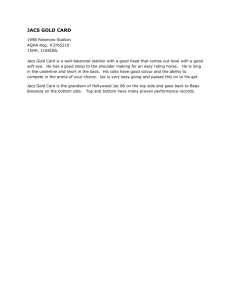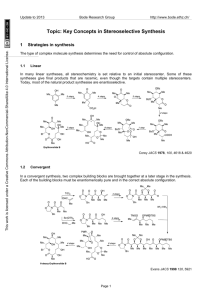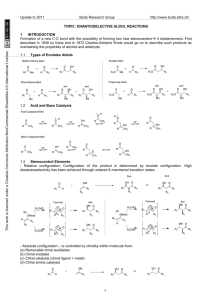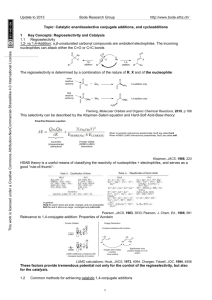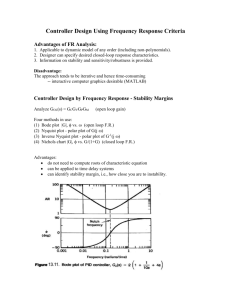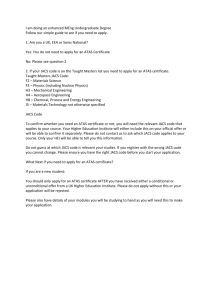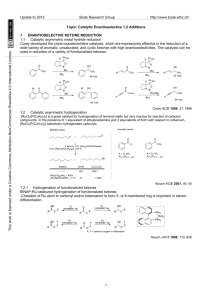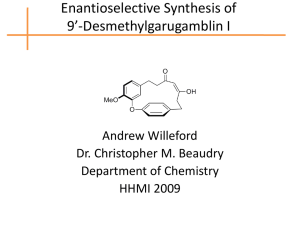Word
advertisement
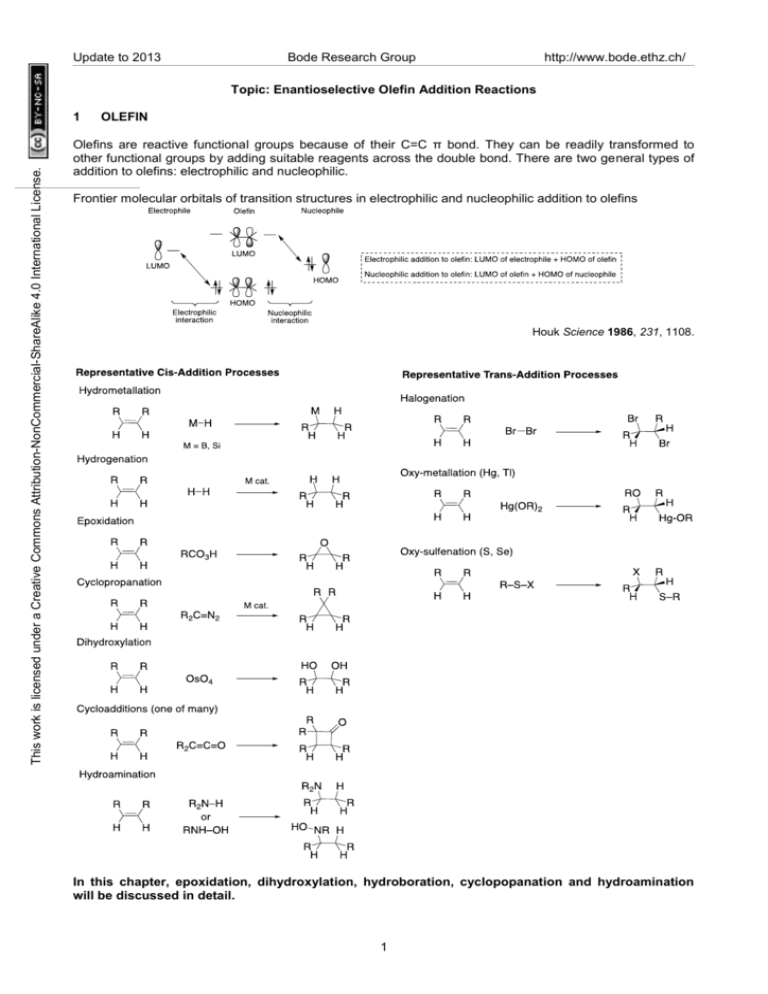
Update to 2013 Bode Research Group http://www.bode.ethz.ch/ Topic: Enantioselective Olefin Addition Reactions This work is licensed under a Creative Commons Attribution-NonCommercial-ShareAlike 4.0 International License. 1 OLEFIN Olefins are reactive functional groups because of their C=C π bond. They can be readily transformed to other functional groups by adding suitable reagents across the double bond. There are two general types of addition to olefins: electrophilic and nucleophilic. Frontier molecular orbitals of transition structures in electrophilic and nucleophilic addition to olefins Houk Science 1986, 231, 1108. In this chapter, epoxidation, dihydroxylation, hydroboration, cyclopopanation and hydroamination will be discussed in detail. 1 This work is licensed under a Creative Commons Attribution-NonCommercial-ShareAlike 4.0 International License. Update to 2013 Bode Research Group 2 EPOXIDATION 2.1 Diastereoselective Epoxidation 2.1.1 Steric effects Epoxidation occurs on the less hindered face http://www.bode.ethz.ch/ Carreira C9.2; Brown JACS 1970, 92, 6914. 2.1.2 Chemoselectivity Epoxidation occurs on the more nucleophilic alkene Carreira C9.2; Vandewalle Tetrahedron 1983, 39, 3049. 2.1.3 Directing group effects Hydrogen bonding or metal coordination leads to directed reactions. Hoveyda Chem. Rev. 1993, 93, 1307 Stereoselective allylic alcohol epoxidation via “butterfly” mechanism. Amides direct epoxidation as well. Hoveyda Chem. Rev. 1993, 93, 1307 Stereochemical outcome of directed epoxidations of acyclic , allylic substrates: 2 This work is licensed under a Creative Commons Attribution-NonCommercial-ShareAlike 4.0 International License. Update to 2013 Bode Research Group http://www.bode.ethz.ch/ Carreira C9.2 2.2 Enantioselective epoxidation 2.2.1 Sharpless asymmetric epoxidation of allylic alchohols Barry Sharpless was awarded the 2001 Nobel Prize for his contributions in stereoselective oxidations on olefins (epoxidation, dihydroxylation). His titanium-tartrate complexes with t-BuOOH readily epoxidize allylic alcohols catalytically and enantioselectively. In his subsequent reports, Sharpless found that addition of 3Å or 4Å increase the scope of Ti(IV)catalyzed epoxidation and decrease the catalyst loading to 5-10 mol%. Sharpless JACS 1980, 102, 5974; Sharpless JACS 1987, 109, 5765. Application of Sharpless asymmetric epoxidation to total synthesis of Amphotericin B and Venustatriol 3 This work is licensed under a Creative Commons Attribution-NonCommercial-ShareAlike 4.0 International License. Update to 2013 Bode Research Group http://www.bode.ethz.ch/ Nicolaou JACS 1988, 110, 4672. Carreira C9.3; Sharpless JACS 1987, 109, 5765; Corey TL 1988, 29, 3171. 2.2.2 Yamamoto’s vanadium-catalyzed enantioselective epoxidations Epoxidation of allylic alcohols with Vanadium and bishydroxamic acid complex is highly enantioselective. Other great features include mild reaction conditions, 1 mol % or less catalyst loading is needed and aqueous t-BuOOH(TBHP) can be used as achiral oxidant. Yamamoto ACIE 2005, 44, 4389. Recently, Yamamoto reported catalytic enantioselective epoxidation of homoallylic and bishomoallylic alcohols (more challenging substrates) using Zirconium(IV) and Hafnium(IV) with bishydroxamic acid (BHA). - Hafnium(IV) catalyzed system gives better yield and ee’s. - Works very well with homoallylic alcohols. - Bishomoallylic alcohols show lower reactivities and require higher catalyst loading (10 mol%). 4 This work is licensed under a Creative Commons Attribution-NonCommercial-ShareAlike 4.0 International License. Update to 2013 Bode Research Group http://www.bode.ethz.ch/ Yamamoto JACS 2010, 132, 7878. 2.2.3 Jacobsen and Katsuki’s Mn-salen complex catalyzed epoxidations Unfunctionalized olefins that lack the specific directing group (e.g. allylic alcohol) are limited to enantioselective oxidation by Sharpless asymmetric epoxidation. Because of the lack of efficient catalytic system, enantioselective epoxidation of unfunctionalized olefins has since been a long-standing goal. The first breakthrough in epoxidizing unfunctionalized olefins was made by Jacobsen and Katsuki independently in 1990 (Katsuki Tet. Lett. 1990, 31, 7345 and Jacobsen JACS 1990, 112, 2801). Chiral Mn-salen complexes povide a convenient and inexpensive procedure for efficient asymmetric epoxidation of unfunctionalized olefins. Cis-olefins works very well for this catalysis, however, trans-olefins tend to be poor substrates (low reactivity and enantioselectivity). Jacobsen JACS 1991, 113, 7063. 5 This work is licensed under a Creative Commons Attribution-NonCommercial-ShareAlike 4.0 International License. Update to 2013 Bode Research Group http://www.bode.ethz.ch/ 2.3 Shi’s dioxirane catalyzed epoxidation Complimentary to Mn-salen catalyzed asymmetric epoxidation of cis-olefins, Shi’s fructose-derived chiral ketone enantioselectively epoxidize trans-olefin in combination with oxone. The first procedure Shi reported was highly enantioselective for trans-olefin, but not catalytic. Subsequent optimizations showed that higher pH (10.5 compared to 7-8 previously) increase the efficiency of the ketone catalyst. At higher pH, the competing ketone decomposition pathway via Baeyer-Villiger reaction is suppressed since high pH favors the equilibrium of intermediate 2 towards 3 (see mechanism below). Great enantioselectivities can be obtained with trans-olefins. Very low enantioselectivities observed with cis-olefins. 6 This work is licensed under a Creative Commons Attribution-NonCommercial-ShareAlike 4.0 International License. Update to 2013 Bode Research Group http://www.bode.ethz.ch/ Shi JACS 1996, 118, 9806; JOC 1997, 62, 2328; JACS 1997, 119, 11224. Synthesis of Shi’s catalyst 1 and its enantiomer. Catalyst 1 and ent-1 both show same enantioselectivity for epoxidation reaction. Shi JACS 1997, 119, 11224. 2.4 Shibasaki’s Lanthanoid complex catalysis Shibasaki catalyst using La(OiPr)3 and BINOL efficiently catalyze asymmetric epoxidation of ,-unsaturated ketones with high yields and enantioselectivities. Shibasaki JACS 2001, 123, 2725. 7 Update to 2013 This work is licensed under a Creative Commons Attribution-NonCommercial-ShareAlike 4.0 International License. 2.5 Bode Research Group http://www.bode.ethz.ch/ Jorgensen’s chiral pyrrolidine catalysis of ,-unsaturated aldehydes Jorgensen JACS 2005, 127, 6964. 3 ALKENE DIHYDROXYLATION Another great contribution of Sharpless in the field of asymmetric catalysis is his asymmetric dihydroxylation. Initially, asymmetric dihydroxylation was performed with stoichiometric amounts of cinchona alkaloids and osmium tetroxide, upon addition of cooxidant NMO or later K3Fe(CN)6, the process became catalytic with both osmium and the chiral ligand. In the case with K3Fe(CN)6 as the cooxidant, the reaction is performed under biphasic conditions. K2OsO2(OH)4 is used as the Os source because it’s not volatile. Premixes called “AD-mix” containing K2OsO2(OH)4, K3Fe(CN)6 and chiral bidentate ligand were formulated and available commercially. Dihydroxylation is applicable to almost all alkene substrates (see substrate scope below). MeSO2NH2 was found to increase the rate and catalytic turnovers of dihydroxylation. It was added to all reaction, except in the case of terminal olefins. 8 This work is licensed under a Creative Commons Attribution-NonCommercial-ShareAlike 4.0 International License. Update to 2013 Bode Research Group http://www.bode.ethz.ch/ Sharpless Chem. Rev. 1994, 94, 2483. Chemoselectivity of asymmetric dihydroxylation: Application in exhaustive dihydroxylation of Squalene: Sharpless JACS 1992, 114, 7570; Science 1993, 259, 64. 4 ALKENE HYDROBORATION Hydroboration of alkene leads to the addition of a boron group and a hydride across its double bond. The organoborane generated by hydroboration serves as a very useful handle for further functionalizations. Experimentally, hydroborations are simple to carry out, they have low toxicity and the reagents used are inexpensive and readily available. 4.1 Uncatalyzed hydroboration reaction The uncatalyzed hydroboration is regioselective, giving anti-Markovnikov product. Dougherty Modern Physical Organic Chemistry, C10.7, p555. 4.2 Enantioselective hydroboration Chiral boronate ester products of alkene hydrobration are useful synthetic intermediates. These substrates can be formed either using chiral reagents or asymmetric catalysis. Catalytic hydroboration and subsequent oxidation to the alcohol remained as the most common reaction sequence. Transformation of the C-B bond into C-N and C-C bonds with retention of stereochemistry significantly expanded the synthetic utility of the catalytic enantioselective hydroboration reaction. 9 This work is licensed under a Creative Commons Attribution-NonCommercial-ShareAlike 4.0 International License. Update to 2013 Bode Research Group http://www.bode.ethz.ch/ Crudden EJOC 2003, 4695. 4.2.1 Rhodium-catalyzed enantioselective hydroboration with chiral bisphosphane ligands 4.2.1.1 BINAP In 1991, Hayashi reported catalytic enantioselective hydroboration of styrenes in the presence of Rh(I) and BINAP. An intriguing feature of this reaction is the complete reversal of regioselectivity observed in the catalytic hydroboration relative to the uncatalyzed reaction. 1. Ph OH Anti-Markovnikov product O BH , O [Rh(COD)2]+BF4- (1%), (+)BINAP (2%), DME, -78 °C, 2 hrs, MeOH quench Uncatalyzed Ph OH Ph 2. H2O2/NaOH CH3 91% yield 96% ee Catalyzed Markovnikov product Crudden EJOC 2003, 4695. The high regioselectivity observed in the rhodium-catalyzed hydroboration of styrenes was rationalized by the formation of -benzyl complex (see catalytic cycle below). Hayashi Tetrahedron: Asymmetry 1991, 2, 601. 4.2.1.2 C2-Symmetrical 1,2-diphosphanes Knochel’s chiral diphosphanes demonstrated excellent chemo-, regio- and enantioselectivity in the Rh-catalyzed hydroboration of styrene derivatives. 10 This work is licensed under a Creative Commons Attribution-NonCommercial-ShareAlike 4.0 International License. Update to 2013 Bode Research Group http://www.bode.ethz.ch/ Knochel ACIE 2001, 40, 1235. 4.2.2 Rhodium catalyzed enantioselective hydroboration with chiral P,N ligand 4.2.2.1 QUINAP QUINAP is one of the P,N class of ligand that are highly successful in asymmetric hydroboration. The substrate scope using QUINAP is wider; moderate to high levels of enantioselectivity can be induced on electron-rich and electron poor styrenes, vinylarenes and -substituted vinylarenes. Electron-rich styrenes generally give better ee than electron-poor styrenes. Brown CEJ 1999, 5, 1320. 5 CYCLOPROPANATIONS [Reviews: Charette Chem. Rev. 2003, 103, 977-1050 and Pellissier Tetrahedron 2008, 64, 7041] 5.1 Classes of cyclopropanation reactions The importance of cyclopropanes is exemplified in the following ways: - The occurrence of cyclopropanes in natural and medicinally important compounds - The function of cyclopropanes as a mechanistic probe - The use of cyclopropanes in key synthetic transformations including vinylcyclopropane rearrangements and divinylcyclopropane Cope rearrangements 11 This work is licensed under a Creative Commons Attribution-NonCommercial-ShareAlike 4.0 International License. Update to 2013 Bode Research Group http://www.bode.ethz.ch/ 5.2 Simmons-Smith type cyclopropanations 5.2.1 Simmons-Smith reaction overview Applicable to a wide range of olefins (simple, electron deficient, electron rich) Electron rich alkenes react faster (because of electrophilicty of zinc reagent) Stereospecific (cis alkenes give syn cyclopropanes and trans alkenes give anti cyclopropanes) Butterfly-like transition state Typical conditions: Zn/Cu, CH2I2, Et2O (In current procedures, Zn/Cu is often generated by the treatment of zinc powder with a CuSO4 solution.) Seminal publications: Simmons and Smith J. Am. Chem. Soc. 1958, 80, 5323 and ibid. 1959, 81, 4256 5.2.2 Directing effects and Modifications The Simmons-Smith reaction exhibits a strong directing effect and rate enhancement (with zinc and also samarium (see Molander modification, below) when the alkene bears a heteroatomcontaining functional group, and the methylene is delivered to the face of the alkene that is proximal to the heteroatom. Charette J. Organomet. Chem. 2001, 702 Furukawa: Use of Et2Zn instead of Zn/Cu [to form presumably EtZnCH2I or Zn(CH2I)2] in a noncoordinating solvent - Preferred for less nucleophilic alkenes Furukawa Tetrahedron Lett. 1966, 7, 3353 and Tetrahedron 1968, 24, 53 Molander: Use of a samarium/mercury amalgam instead of zinc - Selectively cyclopropanates allylic alcohols in the presence of other olefins 12 This work is licensed under a Creative Commons Attribution-NonCommercial-ShareAlike 4.0 International License. Update to 2013 Bode Research Group http://www.bode.ethz.ch/ Molander JOC, 1989, 54, 3525 and ibid. 1987, 52, 3942 Yamamoto: Use of trialkylaluminums and CH2I2 (yielding R2AlCH2I) - Selectively cyclopropanates unfunctionalized olefins Yamamoto JOC, 1985, 50, 4412 5.2.3 Use of chiral auxiliaries in the Simmons-Smith reaction Allylic ether chiral auxiliary approach using carbohydrates: Charette Tetrahedron Lett. 1993, 34, 7157 Acetal approach using tartaric acid derivatives: Yamamoto JACS 1985, 107, 8254 Mash JOC 1990, 55, 2045 5.2.4 Enantioselective Simmons-Smith reactions using stoichiometric chiral additives First reports of controlling absolute stereochemistry in Simmons-Smith reaction: Inoue: 15% yield and 3.4% ee using ()-menthol and IZnCH2I (JOC 1968, 33, 1767 and ibid. 2141) Furukawa: cyclopropanation of vinyl ethers using L-leucine as an additive (Tetrahedron Lett. 1968, 9, 3495) Denmark: modest enantioselectivities using (1R,2S)-N-methylephedrine-modified halomethylzinc reagent to cyclopropanate cinnamyl alcohol (Synlett 1992, 229) First practical report of a stoichiometric chiral additive: Fujisawa Chem. Lett. 1992, 61 13 Update to 2013 Bode Research Group http://www.bode.ethz.ch/ Charette’s dioxaborolane This work is licensed under a Creative Commons Attribution-NonCommercial-ShareAlike 4.0 International License. Major breakthrough by Charette in 1994: Use of amphoteric, bifunctional ligands derived from (R,R)()-N,N,N’,N’-tetramethyltartartic acid diamide and butylboronic acid. Me2NOC 1. O CONMe2 O B (1.1 equiv) CH2Cl2 Bu Ph Ph OH 2. Zn(CH2)I2 (2.2 equiv) CH2Cl2, 25 °C, 2 h OH > 98% yield, 93% ee Charette JACS 1994, 116, 2651 Reaction proceeds well with cis- and trans-disubstituted allylic alcohols and with tetra-substituted allylic alcohols but only with some tri-substituted allylic alcohols. For > 1 mmol scale, DME complex, Zn(CH2I)2DME, is used due to the exothermicity of Zn(CH2I)2 or zinc alkoxide formation (Charette JOC 1995, 60, 1081) Extended to the cyclopropanation of homoallylic alcohols (Charette JACS 1998, 120, 11943) Paterson Angew. Chem., Int. Ed. 2001, 40, 603 Shi’s dipeptide In 2003, Shi reported the use of a chiral dipeptide that could be used stoiciometrically to enantioselectively cyclopropanate unfunctionalized (i.e., lacking a directing group) olefins (in 72– 91% ee). 14 Update to 2013 Bode Research Group Boc N H http://www.bode.ethz.ch/ N O CO2Me Boc (1.25 equiv) N Zn H 2C I This work is licensed under a Creative Commons Attribution-NonCommercial-ShareAlike 4.0 International License. N-Boc-L-Val-L-Pro-OMe ZnEt2, CH2I2 CH2Cl2, -40 °C, 48 h 71% yield, 72% ee unfunctionalized olefins N O CO2Me proposed active chiral cyclopropanating reagent Shi JACS 2003 125, 13632 In preliminary efforts, the Shi group found that by using an achiral additive (e.g., ethyl methoxyacetate) to coordinate the zinc methylenating reagent (e.g., Zn(CH 2I)2), background cyclopropanation could be reduced and substoichiometric amounts of the chiral ligand could be used: Shi Tetrahedron Lett. 2005, 2737 5.2.5 Catalytic enantioselective Simmons-Smith cyclopropanations C2-symmetric chiral disulfonamide ligands Kobayashi reported in 1992 that the Simmons-Smith cyclopropanation could be accelerated by a chiral Lewis acid. Thus, they were able to use C2-symmetric chiral disulfonamide ligands in catalytic amounts to effect cyclopropanations in 13-82% ee. Kobayashi Tetrahedron Lett. 1992, 33, 2575 Tetrahedron 1995, 51, 12013 Kobayashi et al. also showed that zinc may be replaced by aluminum in this reaction (Kobayashi Chem. Lett. 1994, 177) Denmark conducted an in-depth study of the chiral disulfonamide-catalyzed reaction and found that: o It is important to preform the ethylzinc alkoxide and Zn(CH2I)2 o The reaction displays autocatalytic behavior due to the generation of ZnI2 and using ZnI2 as an additive is beneficial to the reaction. NHSO2Me NHSO2Me o The most efficient promoter is: o One or two substituents on the 3-position of the allylic alcohol are well tolerated, but substituents on the 2-position are not. 15 This work is licensed under a Creative Commons Attribution-NonCommercial-ShareAlike 4.0 International License. Update to 2013 Bode Research Group http://www.bode.ethz.ch/ Denmark Tetrahderon Lett. 1995, 36, 2215; ibid. 2219 Pure Appl. Chem. 1996, 68, 23 Angew. Chem., Int. Ed. 1998, 37, 1149 JOC 1997, 584; ibid. 3390 5.3 Cyclopropanations using diazoalkane-generated carbenoids 5.3.1 General catalytic cycle Metal-carbenoid cyclopropanation is a concerted but asynchronous process which involves a buildup of positive charge on one of the olefin carbons. Salvatella and García JACS, 2001, 123, 7616 Rasmussen et al. Chem. Eur. J. 2002, 8, 177 Moser, JACS 1969, 91, 1135 5.3.2 Seminal publication In 1966, Nozaki reported that homogeneous, chiral copper complexes could catalyze the decomposition of diazo compounds to yield carbenoids that react with olefins to yield the corresponding cyclopropanes with a small degree of optical activity. Nozaki Tetrahedron Lett. 1966, 5239 and Tetrahedron 1968, 24, 3655 5.3.3 Cyclopropanation using diazomethane Diazomethane can be decomposed by palladium to yield cyclopropane products (with good dr for cyclic olefins but poor dr for acyclic olefins), but efforts by Denmark to perform an enantioselective cyclopropanation using diazomethane failed likely due to decomplexation of the ligand during the reaction. Denmark JOC 1997, 62, 3375 Charette has studied the cyclopropanation of simple cinnamate derivatives using diazomethane with 16 Update to 2013 Bode Research Group http://www.bode.ethz.ch/ chiral bis(oxazoline)-copper(I) complexes and has achieved good to moderate ee’s. (Charette Tetrahedron: Asymm. 2003 14, 867) Copper: Intermolecular (and intramolecular) cyclopropanations using -diazoesters Copper is the most effective and general metal for intermolecular cyclopropanations using diazoesters when the trans diastereomer is desired. o In general, a bulky ester is required to maximize the trans:cis ratio. This work is licensed under a Creative Commons Attribution-NonCommercial-ShareAlike 4.0 International License. 5.3.4 Following Nozaki’s report of a chiral salicylaldiminato copper complex in 1966 (see above), Aratani and coworkers further developed this ligand scaffold, though generality was moderate: Aratani Tetrahedron Lett. 1977, 18, 2599 Pure Appl. Chem. 1985, 57, 1839 Chiral, C2-symmetric bidentate bisoxazoline ligands are most widely used for enantioselective, copper-catalyzed cylopropanations Pfaltz Angew. Chem., Int. Ed. 1986, 25, 1005 Pfaltz Tetrahedron 1992, 48, 2143 Masamune Tetrahedron Let. 1990, 31, 6005 Evans JACS 1991, 113, 726 Bisoxazoline ligands are very effective for the intermolecular copper-catalyzed cyclopropanation of mono- and 1,1-disubstituted alkenes. o BHT (BHT = 2,6-di-tert-butyl-4-methylphenyl) esters can be cleaved to the corresponding primary alcohol by reduction with LiAlH4 17 This work is licensed under a Creative Commons Attribution-NonCommercial-ShareAlike 4.0 International License. Update to 2013 Bode Research Group http://www.bode.ethz.ch/ Preferred approach of olefin for cyclopropanation using Pfaltz ligand: Reiser showed that furans could be successfully cyclopropanated with good ee and has applied this methodology to the synthesis of the core of several natural products. Reiser Tetrahedron: Asymm. 2003, 14, 765; Chem.Eur. J. 2003, 9, 260; Org. Lett. 2003, 5, 941 Intramolecular application of Evan’s bisoxalzoline-copper(I) catalyst in natural product synthesis: Overman JACS 1999, 121, 5467 Corey’s synthesis of sirenin using a “non-traditional” bisoxazoline ligand scaffold for an enantioselective, intramolecular cyclopropanation. 18 This work is licensed under a Creative Commons Attribution-NonCommercial-ShareAlike 4.0 International License. Update to 2013 Bode Research Group http://www.bode.ethz.ch/ Corey Tetrahedron Lett. 1995, 36, 8745 Macrocyclic cyclization cyclopropanations typically work well using CuPF 6 with Evans’ bisoxazoline ligand: Doyle JACS 2000, 122, 5718 5.3.5 Rhodium For intermolecular cyclopropanation reactions using vinyl and aryl diazoesters, rhodium catalysts are generally preferred. Rhodium complexes efficiently decompose unsaturated diazoaceates to yield cyclopropane products with high diastereocontrol [Rh2] CO2R' CO2R' R N2 R Model for diastereoselectivity in rhodium-catalyzed cyclopropanation: The presence of an electron-withdrawing substituent (ester) and electron-donating substituent (vinyl group) is important for high diastereoselectivity. Alkene approaches from the side of the ester; the developing positive charge on the more substituted alkene carbon may be stabilized by the carbonyl oxygen. OR R O OR OR clockwise rotation O Rh bulky ligand R Rh R R O OR Rh bulky ligand bulky ligand O For diazo compounds of the type (H)(EWG)C=N 2, diastereocontrol is generally inferior to that obtained with copper, ruthenium, and cobalt carbenes. Representative rhodium(II) catalysts: (“paddle-wheel”/”Schaufelrad” structure) 19 Update to 2013 Bode Research Group http://www.bode.ethz.ch/ Chiral carboxamidate catalyst (Doyle) Achiral catalyst Chiral carboxylate catalyst (Davies) R Me O O O MeO2C Rh Rh CO2Me N O O O O O This work is licensed under a Creative Commons Attribution-NonCommercial-ShareAlike 4.0 International License. O O Me N Me Rh Rh MeO2C O Me Rh2(OAc)4 O N O H O N O SO2 N O Rh Rh O CO2Me O O O R Rh2(S-DOSP)4 11 Rh2(5S-MEPY) 4 Rh H O N SO2 CO2Me Rh O Me N R Rh Rh O Rh O Rh O 4 4 11 4 Doyle pioneered the use of chiral dirhodium(II) (specifically, using carboxamidate ligands) catalysts with-diazo carbonyl compounds to generate reactive rhodium carbenoids capable of efficient asymmetric cyclopropanation. CO2Me N Rh O Me 4 H Me Rh O N2 Me H Me Rh2(5S-MEPY)4 (1 mol%) O H O O 82% yield, 99% ee Doyle JACS 1991, 113, 1423 Davies has developed a series of chiral dirhodium(II) carboxylate catalysts which efficiently decompose unsaturated diazoacetates to the corresponding rhodium carbenoids that participate in enantioselective cyclopropanation reactions: Rh H O O O Ph N SO2 Rh2(DOSP)4 Ph Rh O OMe OMe Ph N2 68% yield, 98% ee 11 4 Davies JACS 1996, 118, 6897 Davies showed that alkynyl diazoesters are also competent in Rh(II)-catalyzed enantioselective cyclopropanations. Rh H O Ph Ph Rh2(DOSP)4 AcO N2 CO2Me pentane, -78 °C N SO2 AcO Rh O CO2Me 61% yield, >94% de, 95% ee 11 4 Davies Tetrahedron Lett. 2000, 41, 8189 Doyle demonstrated that alkynes could be cyclopropanated using his rhodium carboxamidate catalyst system to form cyclopropenes: 20 Update to 2013 Bode Research Group http://www.bode.ethz.ch/ Doyle JACS 1994, 116, 8492 This work is licensed under a Creative Commons Attribution-NonCommercial-ShareAlike 4.0 International License. The Davies group has developed a method for the tandem enantioselective diene cyclopropanation/Cope rearrangement, which leads to a seven-membered ring product. This process has been applied to the total sythesis of ()-5-epi-vibsanin E: Davies JACS 1998, 120, 3326 and JACS 2007, 129, 10312 & Davies and Williams JACS 2009, 131, 8329 5.3.6 Cobalt Cobalt catalysts are usually used in cis-selective cyclopropanations though the ligands are complex Katsuki has developed chiral Co(II)-salen complexes that yield cyclopropanes with high cis diastereoselectivities. N N Co O O Ph Ph H N2 CO2t-Bu CO2t-Bu N CO2t-Bu N cis trans (98:2 cis:trans, 98% ee) Katsuki Synlett 1995, 825 and Tetrahedron 1997, 53, 7201 6 HYDROAMINATION [Review: Schulz Chem. Eur. J. 2013, 19, 4972] The hydroamination reaction, which is the addition of an amine to an unsaturated carbon–carbon bond is a reaction with great synthetic potential, as it not only reduces the formation of waste owing to its atom economy, but it also utilizes very simple starting materials. This transformation, thermodynamically feasible under normal conditions, suffers from a high activation barrier due to electrostatic repulsions between the lone pair of the nucleophilic nitrogen atom and the π-orbital of the electron-rich double bond. Reviews have stated that the hydroamination of olefins is thermodynamically favored but experimental equilibrium constants, enthalpies, and entropies for olefin hydroamination in solution are lacking. In 2006, Hartwig reported direct measurements of the equilibrium constants for addition of aromatic amines with varied steric and electronic properties to several types of vinyl arenes. 21 This work is licensed under a Creative Commons Attribution-NonCommercial-ShareAlike 4.0 International License. Update to 2013 Bode Research Group http://www.bode.ethz.ch/ Hartwig JACS 2006, 128, 9306; JACS 2000, 122, 9546 Overall, the reactions are exothermic but nearly ergoneutral. The electronic effect on this reaction is almost purely a result of kinetic, not thermodynamic, factors as the equilibrium constants for these additions are similar (entries 2 vs. 1, 3 vs. 1). In contrast, steric properties of the amine significantly affected the equilibrium constant. The addition of aniline to styrene occurred at a much higher conversion than the addition of N-methylaniline under equilibrium conditions (entries 4 vs. 1-2). Because disubstituted olefins are more stable than monosubstituted olefins, the reactions of aniline to indene and 1,2-dihydronaphthalene (entries 5-6) were limited by thermodynamics. These precise measurements of the thermodynamic parameters for the reactions between amines and olefins of varied structures established benchmark values that can be used to predict which types of hydroaminations will be favorable and which will be unfavorable. The development of novel catalyst systems for hydroamination has seen significant progress in the last two decades but the intermolecular hydroamination of unactivated alkenes with simple amines remains very challenging. It is not too surprising that asymmetric hydroamination reactions have been studied predominantly in intramolecular reactions. Intermolecular reactions have been reported only sporadically and all of these studies were limited to the reaction between aniline derivatives and activated alkenes, such as vinyl arenes, 1,3-dienes and strained bicyclic alkenes. The main limitations of these procedures lie undeniably in the incompatibility of the catalysts with high substrates functionalization. 22 Update to 2013 This work is licensed under a Creative Commons Attribution-NonCommercial-ShareAlike 4.0 International License. 6.1 Bode Research Group http://www.bode.ethz.ch/ Metal-catalysed Hydroamination Activation of Amine: Group 1–5 metal-based catalysts have been proposed to proceed by activation of the amine through a rapid protonolysis, leading to the formation of a metal amido (or imido) complex that will further react through a insertive, non-insertive, or [2π + 2π] mechanism to generate the hydroamination product. On the other hand, oxidative addition of the N-H bond on a late transition metal in low oxidation state may occur to form a metal hydride complex. Subsequent insertion of the C-C double bond into the metal-hydride complex and reductive elimination reaction will afford the hydroamination product. Activation of Alkene: π-Activation of the alkene by a Lewis acidic late transition metal may lead to the nucleophilic attack of the lone electron pair of the nitrogen on the coordinated alkene. The cleavage of the carbon– metal bond by protonolysis will liberate the hydroamination product. 6.1.1 Iridium Togni was the first to report in 1997, an asymmetric intermolecular hydroamination reaction promoted by transition metals. They discovered that binuclear Ir(I) complexes associated to enantiopure diphosphine ligands (JosiPhos, BINAP) delivered the targeted product in high selectivities, in the presence of Schwesinger’s naked fluoride anion as co-catalyst. Togni JACS 1997, 119, 10857 Hartwig have then described the efficient use of an organic base instead of added fluoride, as an attempt to accelerate the reaction through generation of a small amount of aryl amide. The reaction proceeded indeed in the presence of SegPhos, with a low iridium amount delivering the addition product of aniline derivatives to norbornene with very high enantioselectivities and high yields. 23 This work is licensed under a Creative Commons Attribution-NonCommercial-ShareAlike 4.0 International License. Update to 2013 Bode Research Group http://www.bode.ethz.ch/ Hartwig JACS 2008, 130, 12220 Hartwig and his group also succeeded in reacting unactivated aliphatic alkenes and sulfonamides. Applying this methodology to the addition onto bicycloalkenes in the presence of DTBM-SegPhos delivered the hydroamination product in both high yields and enantioselectivities. Other nitrogen-containing heteroaromatic amines have recently been used as the nucleophiles in the intermolecular amination of styrene derivatives catalysed by a cationic Ir-TunePhos complex. Hartwig JACS 2012, 134, 11960 Shibata OL 2012, 14, 780 6.1.2 6.1.3 Palladium Significant studies have been published by the group of Hartwig devoted to the Pd-catalyzed intermolecular hydroamination, allowing the fine-tuning of phosphine-based ligands for the enantioselective hydroamination with enantiomeric excesses of up to 95%. Hartwig JACS 2001, 123, 4366 Rhodium Buchwald reported the first examples of late transition-metal-catalyzed enantioselective intramolecular hydroamination of unactivated olefins. By using [Rh(COD)2]BF4 with binaphthyl-based electron-rich phosphines, they successfully cyclized N-benzyl protected aminoolefins in the corresponding pyrrolidine derivatives under mild conditions in dioxane in high yield and with up to 91 % ee. This reaction could also be performed with substrates lacking gem-substitutions. 24 This work is licensed under a Creative Commons Attribution-NonCommercial-ShareAlike 4.0 International License. Update to 2013 Bode Research Group http://www.bode.ethz.ch/ Buchwald ACIE 2010, 49, 564 6.1.4 Rare-Earth Metals Intermolecular hydroamination reaction of alkenes catalyzed by rare-earth metals has been underdeveloped and remains challenging compared with the cyclohydroamination reaction. The first and only disclosure to date of rare-earth catalyzed asymmetric intermolecular hydroamination of alkenes was reported by Hultzsch in 2010 by using lutetium and yttrium complexes based on chiral 3,3’-bis-substituted binaphthol ligands. Various linear and branched alkenes (ratio alkene/amine 9:1 to 15:1) were converted into their corresponding secondary amines in high conversion (85–100%) and with ee values of up to 61%. Hultzsch ACIE 2010, 49, 1-5 6.1.5 Copper Copper has been recently used as a potential cheap catalyst and Cu(II) triflate and acetate were demonstrated to promote the intermolecular hydroamination of alkenes. In 2013, Miura developed a copper-catalyzed intermolecular formal hydroamination of styrenes with polymethylhydrosiloxane and O-benzoylhydroxylamines with high regioselectivities. Miura ACIE 2013, 52, 10830 In the same year, Buchwald also reported a similar copper-catalyzed hydroamination for synthesizing chiral tertiary amines with high enantioselectivities. They proposed that the insertion of an alkene into a chiral ligand-bound LCu(I)H species would form an alkyl-copper complex (see below). Subsequent oxidative addition of an electrophilic hydroxylamine source followed by reductive elimination would form the C−N bond enantioselectively. The copper(I) species generated would then undergo transmetalation with an external hydride-transfer reagent to reform LCu(I)H species. 25 This work is licensed under a Creative Commons Attribution-NonCommercial-ShareAlike 4.0 International License. Update to 2013 Bode Research Group http://www.bode.ethz.ch/ Buchwald JACS 2013, DOI: 10.1021/ja4092819 Substitution occurs in a regioselective manner to generate a C−N bond at the α-position of styrene derivatives. This method has been shown to be compatible with various substituted styrene derivatives, and styrenes with β-substitution. Additionally, this method allows the development of copper-catalyzed anti-Markovnikov hydroaminations of terminal aliphatic alkenes. Other metals (Au, Pt, Fe, group 4 and 5 metals, alkali bases) have also been tackled as potential catalysts for enantioselective hydroamination. Some breakthroughs are still expected before the successful use of asymmetric metal-mediated hydroamination as a key synthetic procedure for the preparation of scalemic amines or nitrogen-containing heterocycles. 6.2 Metal-free Enantioselective Hydroamination In 2011, Beauchemin described a metal-free catalytic tethered strategy to promote an enantioselective intermolecular hydroamination reaction. The rate of such entropically unfavored transformation could be enhanced by the use of a catalytic organic molecule, appropriately designed as tether for temporary bringing together both reaction partners to react intramolecularly through a Cope-type reaction. Acetaldehyde derivatives were used as the catalyst for the intermolecular Copetype hydroamination of allylic amines and hydroxylamine with high yields and with ee values of up to 97% at room temperature. 26 This work is licensed under a Creative Commons Attribution-NonCommercial-ShareAlike 4.0 International License. Update to 2013 Bode Research Group http://www.bode.ethz.ch/ Beauchemin JACS 2011, 133, 20100; Chem. Eur. J. 2013, 19, 2597 Catalysis of Cope-type rearrangements of bis-homoallylic hydroxylamines are also demonstrated using chiral thiourea derivatives. This intramolecular hydroamination reaction provides access to highly enantioenriched α-substituted pyrrolidine products and represents a complementary approach to metal-catalyzed methods. Jacobsen JACS 2013, 135, 6747 Toste reported that chiral dithiophosphoric acids could catalyze the intramolecular hydroamination and hydroarylation of dienes and allenes to generate heterocyclic products in good yield and enantioselectivity. Dithiophosphoric acid is strong enough to protonate an alkene, but which also possesses a nucleophilic conjugate base. The mechanistic hypothesis of this transformation involves the addition of the acid catalyst to the diene, followed by nucleophilic displacement of the resulting dithiophosphate intermediate. The presence of the sulfur atoms was necessary to reach high conversion and selectivity. 27 This work is licensed under a Creative Commons Attribution-NonCommercial-ShareAlike 4.0 International License. Update to 2013 Bode Research Group 28 http://www.bode.ethz.ch/ Toste Nature 2011, 470, 245
